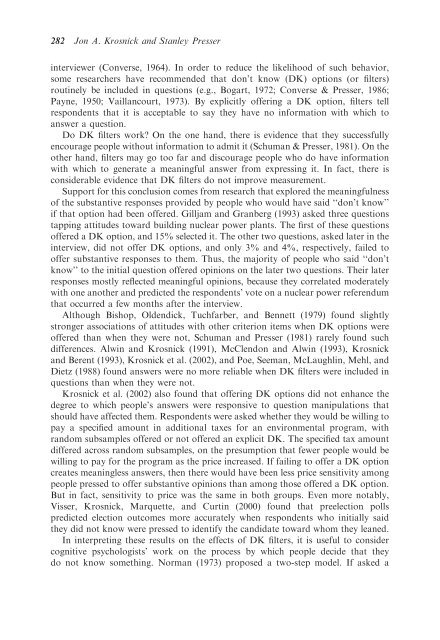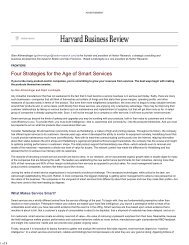Question and Questionnaire Design - Stanford University
Question and Questionnaire Design - Stanford University
Question and Questionnaire Design - Stanford University
Create successful ePaper yourself
Turn your PDF publications into a flip-book with our unique Google optimized e-Paper software.
282 Jon A. Krosnick <strong>and</strong> Stanley Presserinterviewer (Converse, 1964). In order to reduce the likelihood of such behavior,some researchers have recommended that don’t know (DK) options (or filters)routinely be included in questions (e.g., Bogart, 1972; Converse & Presser, 1986;Payne, 1950; Vaillancourt, 1973). By explicitly offering a DK option, filters tellrespondents that it is acceptable to say they have no information with which toanswer a question.Do DK filters work? On the one h<strong>and</strong>, there is evidence that they successfullyencourage people without information to admit it (Schuman & Presser, 1981). On theother h<strong>and</strong>, filters may go too far <strong>and</strong> discourage people who do have informationwith which to generate a meaningful answer from expressing it. In fact, there isconsiderable evidence that DK filters do not improve measurement.Support for this conclusion comes from research that explored the meaningfulnessof the substantive responses provided by people who would have said ‘‘don’t know’’if that option had been offered. Gilljam <strong>and</strong> Granberg (1993) asked three questionstapping attitudes toward building nuclear power plants. The first of these questionsoffered a DK option, <strong>and</strong> 15% selected it. The other two questions, asked later in theinterview, did not offer DK options, <strong>and</strong> only 3% <strong>and</strong> 4%, respectively, failed tooffer substantive responses to them. Thus, the majority of people who said ‘‘don’tknow’’ to the initial question offered opinions on the later two questions. Their laterresponses mostly reflected meaningful opinions, because they correlated moderatelywith one another <strong>and</strong> predicted the respondents’ vote on a nuclear power referendumthat occurred a few months after the interview.Although Bishop, Oldendick, Tuchfarber, <strong>and</strong> Bennett (1979) found slightlystronger associations of attitudes with other criterion items when DK options wereoffered than when they were not, Schuman <strong>and</strong> Presser (1981) rarely found suchdifferences. Alwin <strong>and</strong> Krosnick (1991), McClendon <strong>and</strong> Alwin (1993), Krosnick<strong>and</strong> Berent (1993), Krosnick et al. (2002), <strong>and</strong> Poe, Seeman, McLaughlin, Mehl, <strong>and</strong>Dietz (1988) found answers were no more reliable when DK filters were included inquestions than when they were not.Krosnick et al. (2002) also found that offering DK options did not enhance thedegree to which people’s answers were responsive to question manipulations thatshould have affected them. Respondents were asked whether they would be willing topay a specified amount in additional taxes for an environmental program, withr<strong>and</strong>om subsamples offered or not offered an explicit DK. The specified tax amountdiffered across r<strong>and</strong>om subsamples, on the presumption that fewer people would bewilling to pay for the program as the price increased. If failing to offer a DK optioncreates meaningless answers, then there would have been less price sensitivity amongpeople pressed to offer substantive opinions than among those offered a DK option.But in fact, sensitivity to price was the same in both groups. Even more notably,Visser, Krosnick, Marquette, <strong>and</strong> Curtin (2000) found that preelection pollspredicted election outcomes more accurately when respondents who initially saidthey did not know were pressed to identify the c<strong>and</strong>idate toward whom they leaned.In interpreting these results on the effects of DK filters, it is useful to considercognitive psychologists’ work on the process by which people decide that theydo not know something. Norman (1973) proposed a two-step model. If asked a
















